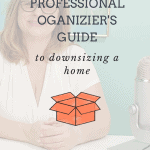Is this your year to downsize? Maybe you are helping a parent move to a smaller more manageable apartment. Or you are just tired of all the stuff and want to have more time and freedom in your life?
In this video, I’ll review 10 steps for downsizing your home with less stress and maybe even a little fun!
1. Set a date
It is helpful to set a date and work backward. Share this date with family members, especially those who may be storing things in your home. Let them know that in one year the remaining belongings will be sold or donated. It gives them notice of when to clear out. And helps you work at a reasonable pace.
2. Shop your Home
You’ll naturally start thinking about all the things you want to let go of and want to spend weekends clearing out cabinets and drawers. I want you to take some time before that to make a list and begin gathering and tagging the things you love and want to move to your new space. Pretend like you have to buy everything new and you are walking into a store. Use full adhesive sticky notes, or low adhesive painter’s tape, or simply snap a photo of your favorite furniture and kitchen appliances that you would buy again if you were starting over. Only pick your favorites, things you would be happy to pay full retail price for again, not just the stuff you’ve accumulated haphazardly over the years. I want downsizing to be a positive experience for you. Think of all the wonderful things you have and how functional and beautiful they will look in your new space.
3. Organize by Category
Organizing one category at a time helps you move through the process more efficiently. Spend a month going through clothing, a few weekends on books, another month recycling and shredding paperwork, then a few weekends sorting the kitchen. It’s easier to make decisions when you have all your options in front of you. It’s easier to pick your favorite pair of jeans when you have all your jeans in front of you. You may find duplicate screwdrivers, flashlights, and can openers, but only once you’ve gathered entire categories of things together by emptying all the cabinets, closets, and drawers where those things live.
4. Digitize!
Bill Gates once said, “The great thing about a computer is that, no matter how much you stuff into it, it doesn’t get bigger or heavier.” Scanning is like a cheat for paper and sentimental clutter. Digitizing papers, letters, photos, recipes, and articles allows you to keep thousands of documents in the palm of your hand. Use tools like Evernote, Dropbox, or Google docs to catalog and organize things. Scanning is time-consuming, so be selective about the papers you want, but if you just have to have it, digitizing gives you the benefit of keeping the information without taking up physical space.
5. Live in the Present
Take a look at your current and future lifestyle and be really honest about the things you use presently. You may have loved scrapbooking and sewing at one time, but now you would rather travel. You may have a shed and garage filled with gardening supplies but now plan to spend more time socializing or reading. Make a list of those hobbies that are part of your present lifestyle, then sell or give away all the parts and pieces associated with those activities from your past.
6. Share Stories and Things
You could have the most amazing year downsizing your home and adopting a simpler lifestyle. One way to do that is to connect with family and friends by passing along treasured items and sharing the story associated with that item. Most things in your home have a story. One reason the downsizing progress takes a long time and is emotionally taxing is that you are revisiting all those stories as you start to move things around. Invite guests over often and let everyone know you are downsizing. You don’t want to push things on people, just talk to them about their hobbies and interests, then find things to pass along. If the interested party lives out of town, snap photos and text them the images.
7. Adopt a Charity
I want you to get real familiar with the charity shops, food banks, shelters, houses of worship, schools, and other non-profits in your community. I tell my clients it is easy to buy something and a lot harder to find someone else who wants it. Find out what these charities need, their drop-off hours, and pick-up options. Always have bags and boxes by your front door labeled with the charity’s name. As they fill up, load them in your car and schedule a drop-off. Some charities have pick-up services. They can be pretty restrictive, like not wanting to go upstairs, or needing an itemized list ahead of time, or wanting pickups scheduled weeks in advance. So often I recommend using a hauling or moving service to deliver the goods.
8. Research the Market
We all think the things in our home have value. Maybe you collected antiques, stamps, or figurines. Collectables that were valuable in the 90s may now sell for pennies on the dollar but something else like vintage technology may be more valuable. See what your things are selling for at local consignment shops and online selling sites like eBay or Facebook Marketplace. If you have unique items, find an appraiser to give you a value. Just keep in mind that the value they give you may be the insurance value and not the dollar amount you would put in your pocket. For example, a piece of jewelry may appraise for $5,000, the buyer pays $2,500 at the consignment shop because buyers of used items rarely pay retail prices, so after the fees are collected by the broker your take is $1,500. It is extremely time consuming and stressful to sell things piecemeal, so do your research and focus on selling those items with the most monetary value.
9. Take a photo
We’ve all heard the phrase take a photo it will last longer. If you want to keep the memory of all the things you collected over a lifetime, but know you will not have room in your new home for every sculpture, collectible, vintage outfit, or bulky piece of antique furniture, take a photo of these items before passing them on. That way you will always have a story to tell. If you keep a record in Evernote, you can keep notes about the object along with the photo in a digital notebook.
10. Hire a Professional Organizer
A downsizing expert helps you stay motivated and on track. Do your research and find a professional organizer experienced in whole-home downsizing. They can help you break down this enormous project into manageable tasks. And it will just be more fun to have a cheerleader on your side.
Are you downsizing for yourself, a parent, or a friend? Leave a comment on my YouTube Channel. And if you are on a very tight timeline, check out my other downsizing video “How to Downsize a Home in 5 days”. If you need assistance downsizing your home in the Richmond Virginia Area, schedule a consultation call with Katherine at www.myspacematters.com/schedule.
Links to common downsizing supplies –
masks
gloves













